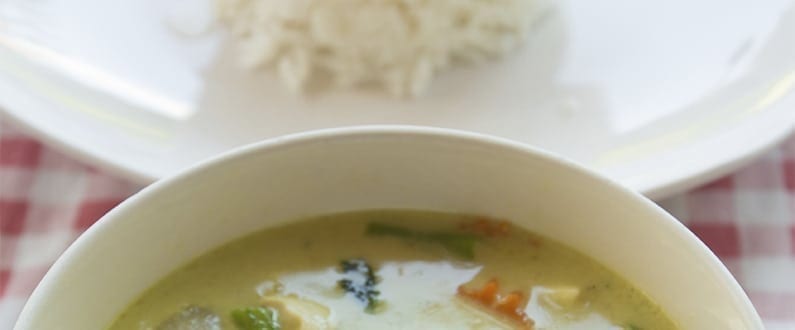Thailand ’s hot and spicy dishes have a unique character that distinguishes them from other Asian diets. This could be because Thailand is the only country in South East Asia never to have been colonised, therefore its food and culinary traditions, like its culture have developed independently from outside influences. The Thai diet is known around the world for its intense, delicious flavour.
Balance and harmony is very important in the Thai diet, many different dishes are served simultaneously to complement each other in texture, flavour and colour. Thai meals are still prepared in traditional ways, and food sharing from communal bowls in the centre of the table is an essential part of both family life and Thai hospitality.
Thai food is characterised by its use of hot chillies, garlic, lemongrass and coconut, which are combined with fresh meat, poultry, seafood and tropical vegetables and fruit. This could also be the reason why Thai people are healthy and do not have the same obesity problems evident in the western world. The use of garlic, for example, is renowned for its health benefits including lowering cholesterol levels, boosting immunity and lowering blood pressure. Throughout Thailand many of the dishes are fundamentally the same. However, there are subtle differences between the different regions. This is true for example with southern curries, which have coconut milk as the main ingredient while northeastern curries use lime juice.
Breakfast Dish
- Jok – Rice porridge, commonly eaten at breakfast time.
- Khao Tom – A rice soup, usually with pork, chicken or shrimp.
Typical Shared Dishes (Central Thailand)
Tom Yam – Hot and sour soup with meat.
Sate – Grilled meat, usually pork or chicken, served with cucumber salad and peanut sauce.
Green Curry – Made with fresh green chillies and flavoured with Thai basil, and chicken or fish meatballs. This dish is one of the spiciest of Thai curries.
Boo Jah – crab cakes with pork, garlic, and pepper served with a simple spicy sauce, such as Sri Rachaa sauce, sweet-hot garlic sauce, nahm prik pao (roasted chilli paste), or red curry paste and chopped green onions.
North-Eastern Shared Dishes
Gai Yang – Marinated grilled chicken.
Larb – Sour salads containing meat, onions, chillies, roasted rice powder and garnished with mint.
Tom saep – Northeastern style hot and sour soup.
Individual Dishes
- Khao pad – One of Thailand’s most common dishes, fried rice, usually with chicken, pork, beef, shrimp, crab, coconut or pineapple. There is also a vegetarian version.
- Pad Thai – Rice noodles pan fried with fish sauce, sugar, lime juice or tamarind pulp, chopped peanuts, and egg combined with chicken, seafood, or tofu.
- Khao soi – Crispy wheat noodles in sweet chicken curry soup.
Desserts
- Kao niao ma muang – Sticky rice and ripe mango.
- Gluay buad chee – Banana in coconut milk.
Throughout Thailand there are many different interpretations of these common dishes. Some dishes of the Northeastern region include ingredients such as raw beef, fermented fish paste and deep-fried insect larvae. The dish nam prik pla too is particularly common in central Thailand because of its low cost.

